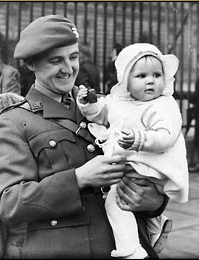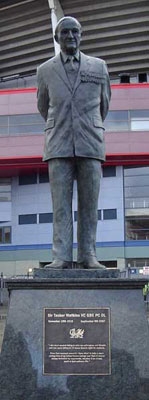Tasker Watkins

SIR TASKER WATKINS VC GBE DL was a Welsh war hero who was prominent in rugby union and the law as Welsh Lord Justice of Appeal and deputy Lord Chief Justice. He was president of the Welsh Rugby Union from 1993 to 2004. In World War II, he was awarded the Victoria Cross, the highest British award for gallantry in the face of the enemy.
He acted as deputy to the attorney-general in the tribunal into the 1966 Aberfan disaster when a coal tip slid onto the south Wales valleys village, killing 144 people, 116 of them children.
Watkins was born November 18, 1918, in the small town of Nelson, Glamorgan, the son of Bertram Watkins, an engine fitter, and his wife Jane. He won a scholarship to Pontypridd Boys’ Grammar School.
In 1931, he moved with his parents to Dagenham in east London. He attended school in Romford where he captained the cricket and football teams and played rugby. After leaving school he worked for export agents and a halibut oil company and became a teacher in London.

Watkins married Eirwen Evans in 1941. They had a son and a daughter.
Following the outbreak of the Second World War in September 1939, Watkins joined the British Army as a private in the Duke of Cornwall’s Light Infantry in October 1939. After serving for over a year as a private he was sent for officer training and was commissioned, with the rank of second lieutenant, into the Welch Regiment on May 17, 1941. He was given the service number 187088 and was posted to the regiment’s 1st/5th Battalion, a Territorial Army (TA) unit.
The battalion was one of three (the others being the 4th Welch Regiment and the 2nd Monmouthshire Regiment) which formed part of the 160th Infantry Brigade, itself being one of three brigades (the others being the 158th and 159th) forming the 53rd (Welsh) Infantry Division.
The division, then commanded by Major General Gerard Bucknall, was serving in Northern Ireland until moving to Wales late in 1941, and then to Kent in April 1942, where it remained for over two years before it was to see any action, until then being engaged in numerous military exercises and training and learning the art of war.
By now a lieutenant, Watkins departed for France with the rest of the 53rd Division, commanded by Major General Robert Ross, arriving there in late June 1944, a few weeks after the initial D-Day landings. The division participated in a number of engagements, such as the Second Battle of the Odon, and, in August, the Battle of the Falaise Pocket.
By mid-August Watkins, commanding ‘B’ Company in his battalion, which had by now been transferred from the 160th Brigade to the 158th Brigade, was one officer in a group leading an assault on a German machine gun post. After all the other officers were killed in the approach, Watkins continued to lead the group and won his VC for leading a bayonet charge against 50 armed enemy infantry and then single-handedly taking out a machine-gun post to ensure the safety of his unit.
He was the first Welsh member of the British Army to be awarded a VC during the Second World War. His citation read: ‘On August 16, 1944, at Barfour, Normandy, France, Lieutenant Watkins’ company came under murderous machine-gun fire while advancing through cornfields set with booby traps. The only officer left, Lieutenant Watkins led a bayonet charge with his 30 remaining men against 50 enemy infantry, practically wiping them out. Finally, at dusk, separated from the rest of the battalion, he ordered his men to scatter and after he had personally charged and silenced an enemy machine-gun post, he brought them back to safety. His superb leadership not only saved his men, but decisively influenced the course of the battle.’
Watkins’ active service ended in October 1944 when he was badly wounded in the battle to liberate the Dutch city of ‘s‑Hertogenbosch, where a memorial service was held for him in St John’s Cathedral in 2007.
Along with many others, he rarely spoke about the war. Of the event which led to him being awarded the VC he simply stated, in a 1955 radio interview: “A good memory is a fine thing, but for those who were there it should not be too good. It should be good enough, however, to recall the great comradeship we had and which we shall never experience again.”
He stated in another interview with The Daily Telegraph in 2001: “You must believe me when I say it was just another day in the life of a soldier. I did what needed doing to help colleagues and friends, just as others looked out for me during the fighting that summer… I didn’t wake up the next day a better or braver person, just different.
“I’d seen more killing and death in 24 hours − indeed been part of that terrible process − than is right for anybody. From that point onwards I have tried to take a more caring view of my fellow human beings, and that, of course, always includes your opponent, whether it be in war, sport, or just life generally.”
Wales rugby coach Graham Henry famously had Watkins’ citation pinned up on the wall of the Welsh changing room as a source of inspiration before Six Nations international encounters.
Watkins later achieved the rank of major, and on leaving the Army, studied law. He was called to the bar (became a barrister) at the Middle Temple in 1948. He became a Queen’s Counsel in 1965, and in 1966 served as Counsel to the Tribunal on the inquiry into the Aberfan disaster, which happened a few miles from his birthplace.
Watkins served as deputy chairman of Radnorshire Quarter Sessions between 1962 and 1971, and of Carmarthenshire Quarter Sessions from 1966 until 1971. He was Recorder of Merthyr Tydfil between 1968 and 1970 and of Swansea during 1970 and 1971. He was Leader of the Wales and Chester Circuit from 1970–71.
In 1971, he was appointed to the High Court bench, where he sat in the Family Division between 1971 and 1974, and thereafter in the Queen’s Bench Division. He was a Presiding Judge of the Wales and Chester Circuit from 1975 until he was promoted to the Court of Appeal (receiving the customary appointment to the Privy Council) in 1980. He became the first Senior Presiding Judge in 1983. Lord Lane appointed him Deputy Chief Justice in 1988, a post in which he continued to serve in under Lane’s successor as Lord Chief Justice, Lord Taylor of Gosforth, until retiring from the bench in 1993.

Watkins played rugby union as an outside-half for the Army, Cardiff RFC and Glamorgan Wanderers. He became president of the Welsh Rugby Union in 1993, overseeing the switch from the amateur era to professionalism and the move from club to regional rugby in Wales.
He stepped down on September 26, 2004, as the first man since Sir David Rocyn Jones in 1953 to hold office for more than one season. His 11 years of service made him the second longest-serving president in the WRU’s 123-year history.
Watkins was also chairman, president of Glamorgan Wanderers, and patron until his death. Watkins was honoured by the club as their First XV team shirt included the letters STW-VC (Sir Tasker Watkins VC) in a green box on the right shoulder. The Wanderers also have a working model statue of Watkins in their clubhouse, donated by Llantwit Major-based sculptor Roger Andrews and stood in a corner that has been called ‘Tasker’s Corner’ by members of the club.
Watkins was knighted in 1971, appointed Knight Grand Cross of the Order of the British Empire (GBE) in 1990 and Knight of Justice of the Order of St John (K.StJ) in 1998.
On April 12, 2006, just over a year before his death, he was made a Freeman of the City of Cardiff, with Lord Mayor Freda Salway describing Watkins as “one of Wales’s most notable citizens.”
After falling at his home in Llandaff in August 2007, Watkins was hospitalised at the University Hospital of Wales, Cardiff. Watkins died, aged 88, at the hospital on September 9, 2007. His funeral was held at Llandaff Cathedral on September 15 and he was later cremated at Thornhill Crematorium. The funeral service was attended by a raft of leading figures from Welsh public life and sport.
Watkins had been appointed an honorary life vice-patron of the Welsh Rugby Union. On announcement of his death, the Welsh team wore black armbands for their 2007 Rugby World Cup game against Canada in Nantes, France, as a tribute to the former WRU president.
He served as president of the University of Wales College of Medicine for 11 years from 1987 and was president of the British Legion in Wales from 1947 to 1968.
Watkins was a chairman of the Mental Health Review Tribunal, Wales Region, between 1960 and 1971 and was also chairman of the Judicial Studies Board during 1979 and 1980.
Among other major appointments, he was named Deputy Lieutenant of Glamorgan in 1956, Honorary Fellow of the Royal College of Surgeons of England in 1992 and held the vice-presidency of the Victoria Cross and George Cross Association from 2002 until 2007.
Watkins was also awarded several honorary degrees, including University of Wales, LL D (1976) and University of Glamorgan, LL D (1996).
A statue of Watkins was commissioned to stand outside Gate C of the Millennium Stadium. The statue, nine feet tall, was created by Llantwit Major-based sculptor Roger Andrews, towards which the Assembly Government contributed £25,000.
His VC and other honours were placed on display in the Lord Ashcroft Gallery at the Imperial War Museum, London.
Among his many accolades, Watkins was referred to during his lifetime as “the greatest living Welshman” and was described by Wales First Minister Rhodri Morgan as “one of the outstanding Welshmen of the 20th Century”.
BACK TO HOME PAGE